Beyond A5: Why Lean Wagyu Deserves More Respect in Tokyo
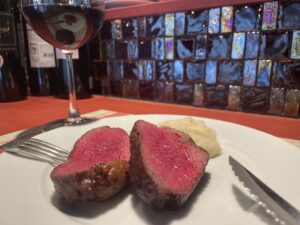
Why You’re Searching This — And Why This Article Matters
You’ve probably heard of A5 Wagyu. You might even be searching for the “best A5 Wagyu in Tokyo.” But somewhere along the way, you’ve started to wonder:
- Is A5 Wagyu really the best?
- Why does it sometimes feel too rich or greasy?
- Is there a more balanced, flavorful Wagyu experience in Tokyo?
This article is for those ready to go beyond the grade — and discover what real Wagyu can be when judged not by fat content, but by flavor, philosophy, and authenticity.
Whether you’re a Tokyo-bound gourmet or a curious traveler, keep reading — because the most memorable Wagyu course might not come with an A5 label.
Why We Need to Rethink Wagyu: A Chef’s Perspective
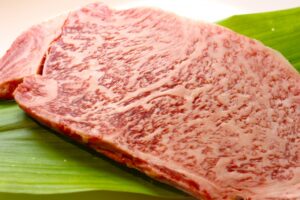
When I trained in France, I learned that luxury in food wasn’t about excess. It was about balance, clarity, and purpose.
I still remember a dish of roasted pigeon, served simply but perfectly. The chef told me, “Real cooking is about restraint. Not how much you can put on the plate—but how little.”
Coming back to Japan, I was struck by the obsession with A5 Wagyu. Every menu proudly shouted its grade. But the more I tasted, the more I felt something was missing: structure, identity, character.
That’s when I discovered lean Wagyu — beef that doesn’t melt away, but tells a story. That demands skill, attention, and respect. Not just from the chef, but from the diner.
This article is for those ready to experience Wagyu in Tokyo not just as a status symbol — but as a reflection of true craftsmanship and culinary heritage.
A5 vs A4 Wagyu: What’s the Real Difference?
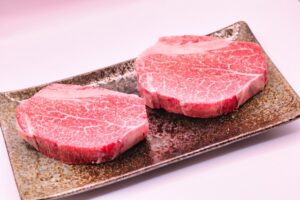
What Separates A4 from A5 in Real Dining
For most diners, the difference between A4 and A5 Wagyu isn’t easy to spot — even by sight.
Officially, the ranking reflects the degree of marbling, but identifying that difference visually takes expert knowledge. Some A4 Wagyu even has more marbling than an A5 cut.
That’s because these grades are not measured by machines — they are assigned visually at auction by trained graders.
In fact, over 86.7% of Japanese Black Wagyu (Kuroge Washu) beef is graded either A4 or A5. Why so many? Because the breed has been selectively developed over decades to produce consistent high-marbled meat.
From how calves are raised to the specialized feed and fattening techniques, everything is geared toward getting higher auction prices — and that means more A4 and A5 beef on the market.
So does A5 always taste better? Not necessarily.
Is A5 Always Better? When A4 Might Be the Right Choice
If you’re expecting a clear difference in taste or texture between A4 and A5 Wagyu, you might be surprised — many people can’t tell them apart.
In fact, in thicker cuts like steak, A4 Wagyu can offer a more balanced flavor, while A5 may feel heavier due to the higher fat content.
In cooking, A5 Wagyu isn’t always the better choice. For example, when using sirloin for roast beef, both A4 and A5 can lose their appeal — the long cooking process causes the fat to melt out, leaving the meat dry and hollow in taste.
But when prepared rare or medium-rare, the fat remains inside, creating the melt-in-your-mouth effect Wagyu is famous for. This is why A5 and A4 Wagyu are often best enjoyed in lightly cooked dishes like sukiyaki or shabu-shabu.
In Japan and especially in Tokyo, where people are accustomed to eating foods in their raw or semi-raw form, this approach is not only accepted — it’s celebrated.
What Lean Wagyu Really Tastes Like (vs A5)
Akaushi doesn’t aim to impress in the first bite. It doesn’t flood your mouth with oil or melt instantly like A5 Wagyu. Instead, it builds — slowly, deliberately.
You first notice the texture — firm, yet tender. Then comes the depth: a savory richness that hints at soil, grass, and heritage. There’s a mineral clarity to it, a kind of umami that doesn’t fade, even after the last bite.
It’s the kind of beef that rewards slow chewing. That pairs with wine not to complement fat, but to highlight origin.
It’s not about luxury. It’s about honesty.
This is why I serve lean Wagyu with restraint — a light jus, a seasonal vegetable, a classical reduction. No distraction. No tricks. Just the beef, doing the talking.

Many travelers assume that A5 Wagyu is automatically the best—especially when dining in Japan. But Wagyu grades are more than just numbers and letters.
Why Lean Wagyu Is Gaining Attention in Tokyo and Abroad
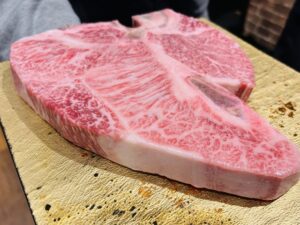
Japan’s Hidden Wagyu — Why Most Travelers Miss Akaushi
Lean Wagyu breeds such as Akaushi, Shorthorn, and Polled account for just around 2% of all Wagyu in Japan. Their rarity is not due to lower quality — but because they are disadvantaged by a system built exclusively for Kuroge Wagyu.
Japan’s beef grading and auction system was originally developed specifically for Japanese Black cattle, which excel in producing high levels of marbling. These breeds consistently receive top rankings and higher prices.
In contrast, lean Wagyu breeds are not evaluated fairly within this system. Even if they offer rich flavor and are raised with care, they receive lower grades simply because they lack heavy marbling. This results in lower market prices.
The biggest reason lean Wagyu remains underrepresented isn’t consumer demand—it’s structural bias. Only a few farmers continue raising these rare breeds out of regional pride, commitment to Japan’s food heritage, and a belief that real flavor should outshine fat content.
Why Some Chefs Prefer Lean Wagyu Over A5
A growing number of chefs in Japan and abroad are choosing lean Wagyu for one reason: flavor clarity.
Unlike A5 Wagyu — where richness comes from fat — lean Wagyu delivers a more direct, meaty character. It holds up to longer cooking methods, such as slow roasting and sous-vide, without losing flavor integrity.
Even after resting or reheating, the taste remains consistent and bold. This makes lean Wagyu ideal for French, Italian, and wine-paired cuisine, where fat can overpower sauces and aromatics.
It’s not just a different breed. It’s a different philosophy of cooking.
Why Most Chefs Avoid Lean Wagyu — and Why That Matters
Lean Wagyu is unforgiving. It exposes every mistake. You can’t overcook it, can’t drown it in sauce, can’t slice it too thin. Every step matters — from resting time to how you pair acidity or salt.
That’s why most restaurants stick with A5 Wagyu. It’s safe. It performs well, even if cooked without finesse. Diners expect softness and marbling — and A5 delivers that, no matter what.
But red Wagyu demands real technique. The kind you only earn over years. The kind that comes from failure, repetition, and humility.
That’s why the few places that serve true lean Wagyu in Tokyo — do so with purpose. Not trend. Not marketing. Philosophy.
Where to Try Lean Wagyu in Tokyo: Real Experiences and Philosophy
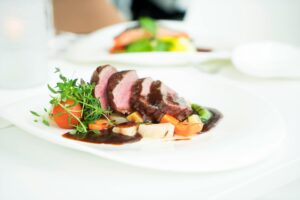
The Challenge of Serving Real Red Wagyu in Tokyo
In Tokyo, lean Wagyu is exceptionally rare — both on the market and on the menu. Unlike the familiar A5 Wagyu experience served at major steakhouses, red-meat Wagyu like Akaushi is usually found only in restaurants that are deeply committed to Japan’s culinary heritage and terroir.
At QUNIOMI, that commitment is clear from the first bite.
Instead of chasing luxury through complexity, the course menu is composed to highlight the true character of red Wagyu: its texture, depth, and evolving flavor.
This is not “minimalist” in appearance only — but a deliberate design philosophy, shaped by the belief that exceptional beef does not need embellishment.
The result? A dining experience that redefines what Wagyu can be. For travelers seeking something beyond fat and marbling, QUNIOMI offers a rare opportunity to rediscover Japanese beef — one that leaves a lasting impression, without relying on excess.
How to Identify True Lean Wagyu Restaurants in Tokyo
Some restaurants claim to offer “lean Wagyu,” but what actually arrives on your plate is often just lean cuts of highly marbled Kuroge Wagyu — like rump or round — not lean breeds.
True red-meat Wagyu is different. You’ll know it by:
- Clearly labeled breed and origin (like “Kumamoto Akaushi”)
- Direct partnerships with small-scale farmers
- Menus designed around showcasing terroir and flavor, not fat
- Seasonal preparation styles matched to the cut and structure
At these rare spots, lean Wagyu isn’t a trend—it’s a statement. It reflects a deeper philosophy: that beef can express character, landscape, and tradition without needing to be drenched in fat.
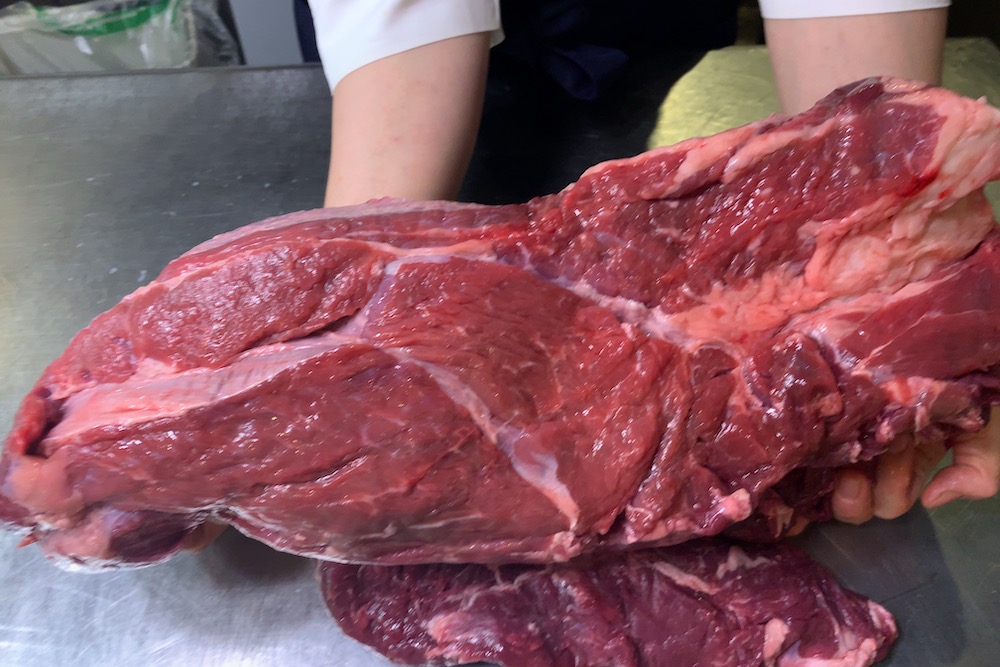
When most people think of Wagyu, they picture the famously marbled Kuroge Washu—the black-haired breed that accounts for nearly 98%
Choosing the Right Wagyu Type in Tokyo: A5 vs Lean Wagyu
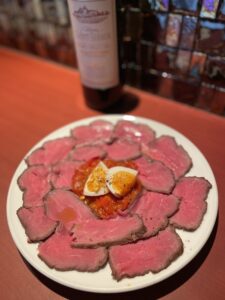
Marbled vs Lean: Understanding Your Flavor Preference
Do you prefer the melt-in-your-mouth sensation of marbled fat, or the bold, satisfying flavor of red meat?
A5 Kuroge Wagyu is known for its buttery texture and luxurious marbling, but many diners find it rich to the point that just a few bites are enough.
In contrast, lean Wagyu breeds like Akaushi and Shorthorn offer a deeper meat flavor, firmer bite, and better pairing with wine — making them ideal for those who appreciate the taste of the beef itself.
If you value sweetness and softness, marbled Wagyu might suit you. But if you’re looking for character and flavor, lean Wagyu delivers a completely different experience.
Cooking Style Matters: French, Sukiyaki, or Steak?
The way Wagyu is cooked plays a major role in what breed is best.
- Steak or teppanyaki: Ideal for enjoying the richness of marbled fat, but it can become overwhelming quickly.
- Shabu-shabu or sukiyaki: These styles highlight the sweetness of the fat, but again, richness dominates.
- French or Italian course menus: Especially when using lean Wagyu, these cuisines allow chefs to showcase their mastery of technique and ingredient knowledge.
In such settings, each dish is crafted with restraint — avoiding excess garnishes — to let the flavor and texture of the meat speak for itself.
Where to Find Rare Breeds like Akaushi in Tokyo
Most diners have never even heard of these breeds — and that’s exactly why food lovers seek them out.
Red Wagyu breeds like Akaushi or Japanese Shorthorn are rarely found on the average restaurant menu. Why? They’re hard to source, less commercially promoted, and require chefs with specialized knowledge to prepare properly.
Take QUNIOMI in Ebisu, for example — a restaurant that builds its entire experience around Akaushi from Kumamoto.
Here, the goal isn’t to show off an “A5” label, but to express the terroir, texture, and integrity of the meat.
These restaurants often work directly with farmers, choosing cattle not for their marbling but for their story. The plates are intentionally minimalist — not out of simplicity, but to let the ingredients shine.
Experience Lean Wagyu in Tokyo at QUNIOMI
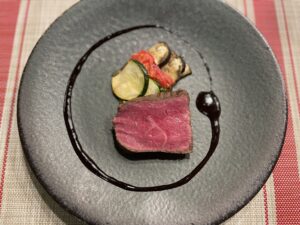
What Makes QUNIOMI Unique Among Wagyu Restaurants in Tokyo
Most Wagyu restaurants in Tokyo focus on A5 Kuroge beef with strong marbling. QUNIOMI is different. The restaurant exclusively serves Akaushi (Japanese Brown) beef raised in Kumamoto — a rare, red-meat Wagyu that almost never appears in mainstream distribution channels.
What sets QUNIOMI apart is not just the beef, but the intention behind every dish.
The course menu is designed specifically to showcase the natural texture and depth of lean Wagyu, without overwhelming it with excessive sauces or visual elements. The presentation is minimalist — but purposeful. It’s about honesty and precision, not excess.
This is where you come to experience Wagyu not as a status symbol, but as a regional food culture.
Signature Akaushi Courses Crafted for Clarity and Character
The courses at QUNIOMI are crafted to reflect the essence of lean Wagyu — from the way it’s seared and rested to how it’s paired with seasonal vegetables, stocks, and wine reductions.
- No overloading the plate with unnecessary elements
- Clear seasonal changes in preparation
- Respect for ingredient origin and regional pride
It’s the kind of experience that turns first-time diners into repeat visitors — not because it’s flashy, but because it’s unforgettable.
Final Thoughts: Why Real Wagyu Is More Than Just A5
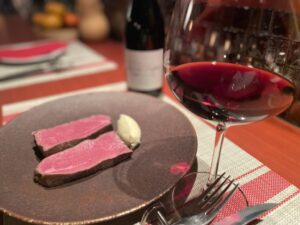
Japan’s Wagyu world is far richer than most travelers realize. From lean breeds like Akaushi to specialized restaurants that honor tradition over trend, there’s more to discover if you look past the A5 label.
Whether you’re a seasoned gourmet or a curious visitor, choosing the right Wagyu in Tokyo is not just about grades — it’s about flavor, heritage, and experience.